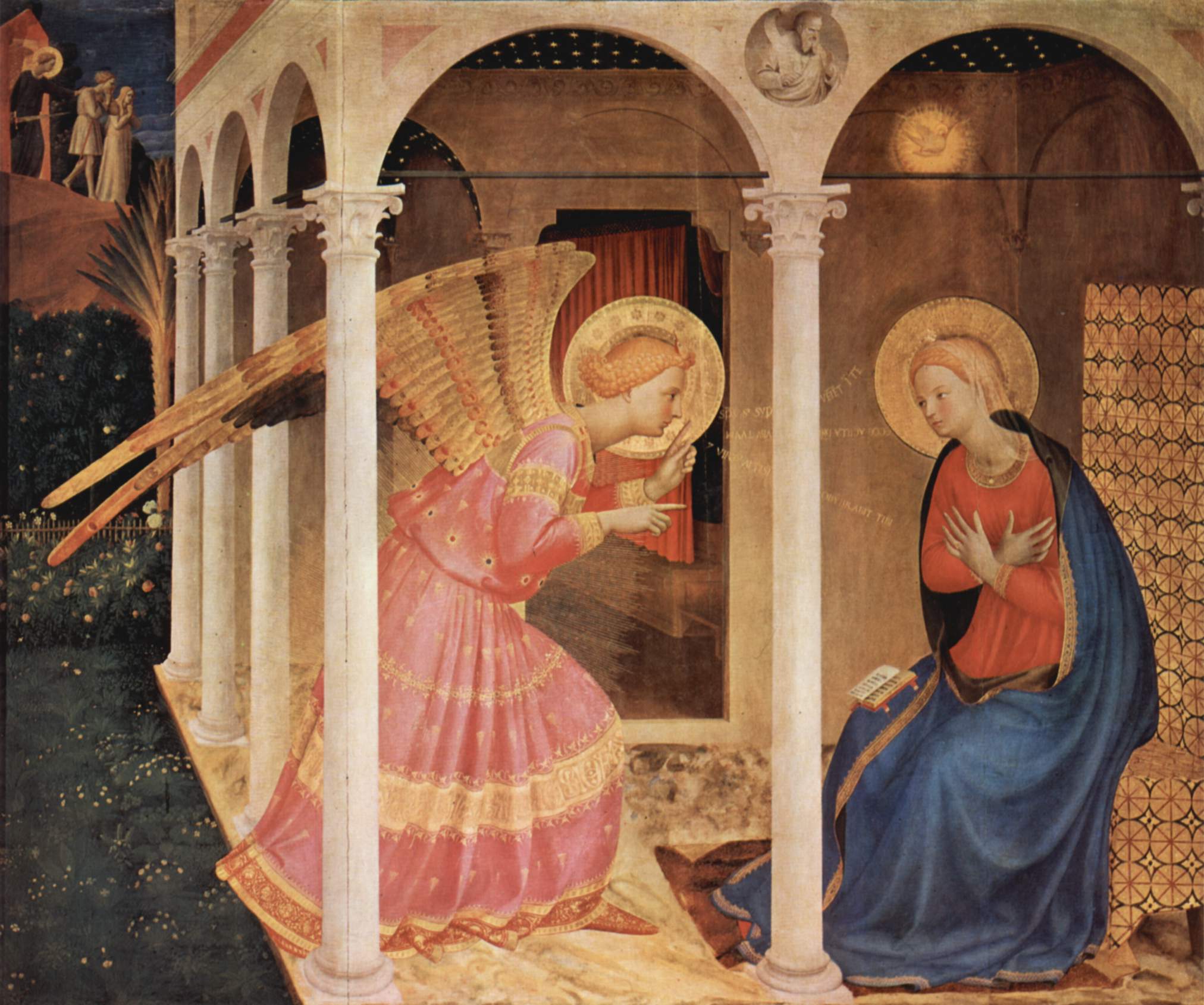For over thirty years my wife and I have visited the Diocesan Museum in Cortona, in Tuscany, to see Fra’ Angelico’s Annunciation. Contemplating it again this year, I was struck by how the painting radiates the beauty of holiness and draws one closely into the mystery which it celebrates.
At the top left of the painting the artist shows the expulsion of Adam and Eve from the Garden of Eden. An angel stands in the doorway of an aedicule; behind him his wings are illuminated by light, but outside all is darkness. Although he holds the sword of judgement to enforce God’s sentence against our first parents, the angel puts his left hand on Adam’s shoulder in a gesture which seems to offer consolation and a sign of future hope. Adam looks crestfallen, hanging his head forwards and holding it in both hands; Eve, her hair falling loosely over both shoulders, wrings her hands beneath her chin.
Yet their expressions are ones of sorrow and contrition rather than of the utter despair shown by Eve in Masaccio’s earlier depiction of the Expulsion from Eden in the Brancacci Chapel in Florence. Angelico’s theology of the Fall is that of the <em>felix culpa</em>, the “happy fault which earned for us so great, so glorious a redeemer” – as the deacon sings in the Exultet at the Easter Vigil.
By contrast to the sombre sadness of the Expulsion, the rest of the painting is suffused by light and joy. The main scene takes place in a portico constructed of white Brunelleschi columns standing on a floor of richly-veined marble. Outside the portico we see a meadow of flowers contained within a hedge and fence, making a <em>hortus conclusus</em>. The enclosed garden, spoken of in the Song of Songs (4:12), was taken to be an allegory of Mary’s virginity.
Within the portico, the Blessed Virgin sits on a rich, gold-brocaded seat, clothed in the royal colours of red and blue as befits the one who will become Queen of Heaven. Yet, despite these adornments, her demeanour of humility is Our Lady’s greatest adornment. She has clearly been interrupted in her devotions, for a small prayer book sits on her lap as if it might fall to the ground, while her hands are crossed at the breast in a gesture of humble receptiveness. Her head is slightly inclined, and she gazes intently at the angel.
Gabriel, meanwhile, is perhaps the most lavishly depicted of all angels in Christian art. His wings are magnificent, and their span extends to almost half of the width of the picture. Each feather is masterfully depicted in burnished gold and red. His halo and the trims and bands of his garment are also of precious gold leaf. Angelico shows him in a half-genuflection, which brings his face and that of the Virgin to exactly the same level. This creates a profound intimacy, reminding us of the mystery of the order of creation.
This intimacy of the two sacred protagonists brings alive the drama of the Incarnation in away that no other depiction of the Annunciation has ever done better. Gabriel’s gestures illustrate the two aspects of the Incarnation, for with the index finger of his left hand he points heavenwards to indicate whence the Redeemer will come whilst with that of his right hand he points to the Blessed Virgin to indicate that it is only with her consent that the mystery can come to pass. The Trinitarian aspect of the Incarnation is emphasised by the depiction of God the Father in the roundel above the central pillar and of the Holy Spirit, symbolised as a dove which hovers over Our Lady as though, until now, He has been waiting patiently for her <em>fiat</em> – vital to enable the angel’s prophecy to be fulfilled.
By a wonderfully naïve and yet wholly convincing conceit Angelico leaves us in no doubt that we are witnessing this moment of consent – he gives us the dialogue between them in beautiful, gilded letters. Through the exchange between Gabriel and the Virgin (her response, “<em>Ecce ancilla Domini: fiat mihi secundum verbum tuum</em>” is written upside down so that the words flow from right to left) we know that this is the very moment of the Incarnation, when God’s Almighty Word took flesh in her womb.
In addition to the Dominican influence in Cortona, there is also a strong Franciscan legacy which can be seen in the Church of San Francesco in which relics of St Francis can be found, and the hermitage of Le Celle where St Francis stayed several times – including on his last journey back to Assisi in 1224 after he had received the stigmata on Mount La Verna. If you’re visiting, don’t miss the magnificent Church dedicated to Santa Margherita, the penitent and Franciscan tertiary, whose body is on display there behind the high altar.
<em>Photo: Fra’ Angelico’s 'Annunciation'.</em>
<em>Graham Hutton is a former chairman of Aid to the Church in Need and deputy chairman of the Orders of Saint John Care Trust</em>
<strong><strong>This article appears in the October 2024 edition of the <em>Catholic Herald</em>. To subscribe to our award-winning, thought-provoking magazine and have independent, high-calibre, counter-cultural and orthodox Catholic journalism delivered to your door anywhere in the world click <a href="https://catholicherald.co.uk/subscribe/?swcfpc=1"><mark style="background-color:rgba(0, 0, 0, 0)" class="has-inline-color has-vivid-cyan-blue-color">HERE</mark></a></strong></strong>.



